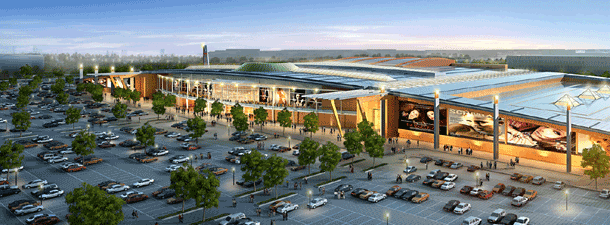An upturn in shopping centre development in Europe is on the horizon, according to a report from Cushman & Wakefield. Although development has been subdued in some countries for the past few years, improving retailer demand and concerns about potential shortages of prime space are contributing to expectations of a rise in development activity in many European countries.
More than 2.1 million sq.m of new shopping centre space in Europe was completed in the first half of 2011, roughly equal to that of the same period in 2010. 71 new shopping centres accounted for 90% of this space, while extensions of existing schemes made up the remaining 10%.
If all the projects scheduled are finished on time, the development total for 2011 will be 26% higher than that of last year when completion levels fell for the second consecutive year. Around 5.4 million sq.m of shopping centre space was completed in 2010, a fall of 29% from 2009 and the lowest annual completion total since 2004.
As with previous years, Central and Eastern Europe accounted for the majority (58%) of new space opened in the first half of 2011 with strong development levels in Russia, Turkey and Poland. The largest scheme completed was Marmara Forum in Istanbul (156,000 sq.m). Just over 400,000 sq.m of shopping space completed in Russia – nearly one fifth of the European total. With the opening of AFIMALL City and two other shopping centres, Moscow accounted for 36% of the new space in Russia. Major projects were also completed in Novosibirsk, Yaroslavl, Kazan and St Petersburg. In Western Europe, Italy and Spain recorded the largest volume of new space added.
5.8 million sq.m of shopping centre space across Europe is scheduled for completion in 2012, although this figure will depend on occupier demand and the pace of economic recovery. Russia and Turkey account for 41% of the H2 2011/2012 pipeline. In Russia, nearly three million sq.m of new space is expected to be completed before the end of next year, including schemes larger than 100,000 sq.m in Krasnodar, Ufa and Samara. In Turkey more than 800,000sq.m is under construction, most of which is located in Istanbul.
In Western Europe, France and Italy top the H2 2011/2012 pipeline table. France is expected to see a rebound in completions after last year’s slowdown. In Italy, several large schemes are in the pipeline, although there is some uncertainty about completion dates after a spate of recent delays.
Elsewhere, notably in Germany and the UK, activity remains subdued. In Germany, the 2011 and 2012 development totals are likely to be the lowest for more than 20 years. In the UK, the 2011 projected completion total is massively skewed by Westfield Stratford City (176,500 sq.m, opened 13 September) which accounts for 81% of the pipeline for the second half of the year. Completions are expected to slow dramatically next year resulting in the lowest annual provision of new shopping centre space in the UK for more than 50 years.
Justin Taylor, UK CEO Retail & Leisure, Cushman & Wakefield said: “We see a number of European locations which have an under-provision of quality retail space and strong retailer demand. The health of many occupational markets has continued to improve, and prime rents have risen in around a third of the countries surveyed. However, occupier demand remains subdued and highly selective in many countries and there is going to be a period of continued uncertainty as further austerity measures across most of Europe take effect.”
European retail investment volume totalled nearly €19.8 billion in the first half, 4% lower than the previous six months’ level and 9% up on the corresponding period of 2010. Retail’s share of total commercial property investment edged up to approximately 35%, up from 33% in 2010.
Germany, Sweden, Russia, Turkey, and a number of smaller CEE markets saw retail investment volumes increase considerably relative to both the previous six months and the first half of 2010. In Germany, retail investment volume increased by 37% year-on-year, while Sweden saw annual growth of nearly 91%. In Russia, Turkey and Italy, Q1 2011 saw the highest quarterly retail transaction totals since 2007/08.
However, several European countries recorded significant declines in activity. In absolute terms, Spain saw the largest year-on-year contraction in Europe: retail volume in the first half was nearly €1.2bn lower than that in the first half of 2010, which amounts to an annual fall of 79%. Norway, France and the Netherlands also saw large declines in investment volume relative to both the previous six months and the corresponding period of 2010. In Norway, retail volume declined by 73% year-on-year; in France, by 36%, and in the Netherlands, by 50%.
Mike Rodda, Head of Cross-border Retail Investment, Cushman & Wakefield, said, “We are in a two-speed market where the core markets (UK, France and Germany), CEE, and increasingly Sweden are attracting the major focus. We have seen really significant yield compression in Poland this year, but the other markets are experiencing much thinner attention. Financing transactions is becoming increasingly problematic and will cause a number of deals to fall down before the year-end. However capital from new sources is growing as a number of larger transactions are attracting joint venture bids or co-investment between fund manager and the larger LP’s.”




















